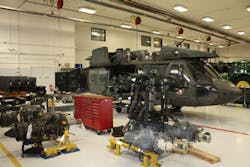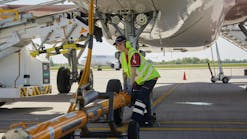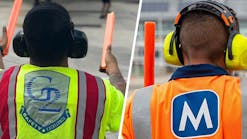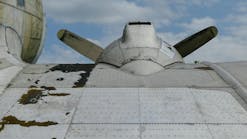Built by United Technology’s Sikorsky Aircraft, the UH-60A Black Hawk helicopter first entered into service with the U.S. Army in 1979. Power for the four-blade main and tail rotors is provided by two GE T700 turboshaft engines. Approximately 3,000 are in use around the world; primarily for military tactical support, troop transport, electronic warfare, combat support, and aeromedical evacuation. AMT spent time with the soldier technicians of the Army Aviation Support Facility (AASF) located at Downtown St. Paul Airport in Minnesota.
The AASF
Keith Shelstad, maintenance test pilot (MTP) for the St. Paul AASF, explains, "This AASF is responsible for the maintenance on 10 Black Hawks operated by the Minnesota Army National Guard Aviation’s 34th Combat Aviation Brigade (CAB). The maintenance organization consists of approximately 40 people."
Shelstad went on to explain most are technicians assigned to flight line or phase maintenance, and a variety of support shop functions such as sheetmetal repair, engine repair, and nondestructive inspection tasks. There are four technical inspectors (TIs), one production controller, and one person assigned to manage the Unit Level Logistics System Aviation (ULLSA) which is the computer system that houses the technical data including the helicopter logbooks.
The group has three maintenance and one inspection supervisors, and two MTPs responsible for maintenance-related helicopter run-ups and the after maintenance test flights. Maintenance management is the responsibility of the maintenance officer, whose role can be compared to a civilian director of maintenance having responsibility for the maintenance, budget, staff, and 10 aircraft.
The Army’s maintenance program
Shelstad explains, "The Army program consists of three maintenance levels: Unit level, intermediate level, and depot level maintenance. Unit and Intermediate Level is what we are authorized to accomplish at the AASF." The preventative maintenance daily (PMD) checks take place daily when the helicopter flies or every seven days if the helicopter is not flying.
The preventative maintenance services (PMS) checks are required every 40 flight hours; they take 15 to 20 man-hours and can generally be accomplished in one day with two technicians. There’s a host of other hourly and calendar driven service and inspections tasks, such as gearbox oil samples, battery checks, 30-day engine wash programs, 90-day corrosions checks, and the 120-hour inspection which takes two to three days and includes critical vibration checks of the engine high-speed shafts, tail rotor, and oil cooler fan.
Unit level also includes the phase maintenance inspection (PMI) which is a large check accomplished every 360 flight hours. Alternating between PMI 1 and PMI 2 with some common tasks, the PMI 1 is primarily focused on the cabin and tail section, while PMI 2 has a focus on the systems and components which are primarily located above the cabin, the main rotor, and tailboom.
Limited depot level maintenance is accomplished by Aviation Classification Repair Depot (AVCRAD). For the Minnesota AASF, Springfield, MO, is the AVCRAD location and covers a 14-state area. When the AASF requires a higher-level of maintenance than it is authorized for, either the helicopter is taken to AVCRAD or a team is sent to accomplish or assist. Sikorsky and GE technical representatives are located at the AVCRAD.
Depot level maintenance is the extensive maintenance or modifications. As an example, several of the Black Hawks maintained by the St. Paul AASF are UH-60 L models, which are upgrades from A models. These upgrades were done at the depot located at Corpus Christi, TX.
Black Hawk maintenance at the AASF
The flight line crew is responsible for the PMD, PMS, unscheduled maintenance, and helicopter ground movements around the facility. For example, technician Shaun Brenner was assigned to troubleshoot and correct a tail rotor deice problem, while technician Cliff Steenberg repaired the tail rotor pylon drive shaft cover. Steenberg says of his career with the National Guard, "I have 34 years of military time between the Army and the National Guard. I’ve been a full-time technician here since 1988." He holds an FAA A&P certificate from when he worked on helicopters prior to his full-time employment with the Guard.
The Phase crew was in week three of a PMI 2 during my visit. There was extensive work taking place including the complete replacement of the tail rotor pylon. Both engines and all four main rotor blades were removed, but the "5-pack" as it was called was still installed. The five-pack includes the main module or gearbox, the two engine input modules, and two accessory drive modules.
Chris Kelly, maintenance supervisor for Phase Maintenance, explains, "Several weeks out we have a phase planning meeting to review the work-scope and make preparations. With a crew of eight technicians working a standard 40-hour work week, completion of these phase checks averages between five and seven weeks."
Terry Johnson, lead technician on the phase check crew was transferring hardware and components from the removed tail rotor pylon over to the replacement. When asked what the most complicated task was on the Black Hawk, he replies, "The complete rigging of the main rotor system can be very complicated." He went on to explain the adjustment of all the control rods from the cockpit to the cabin roof all the way to the torque shafts including the stabilization augmentation system, the control mixing unit, and the forward, aft, and lateral servos that go into the main rotor system.
Maintenance in the heat and the sand
In Iraq, the maintenance organization was operated similarly, having unit, intermediate, and depot level maintenance groups. Generally, the work was accomplished in a cement dome structure known as the hardened area aircraft shelter (HAAS). I was told most days were 10 to 14 hours on duty with one day per week off for things like laundry or catching up on rest. I listened intently as a group of technicians recalled their experiences in Iraq.
When asked about the weather, technician Mike Ricke promptly replies, "The sandstorms were very real and they could last as long as two to three days. I’ll always remember the red color of the sky during a sandstorm."
Technician Dustin Paulson recalls, "We’d close the doors on the HAAS but still everything was eventually covered with dust and sand. We did a lot of cleaning and vacuuming of dust and sand from inside the aircraft during our maintenance checks."
Another part of the sandstorms I was told was they sometimes meant an increase in enemy mortar attacks. Again Ricke says, "In the summer months the temperature would reach a high of 130 F and it would cool down to 90 F at night. During the winter months it would range from about 60 to 30 F."
Flight line checks in Iraq were accomplished using larger crews in a much shorter time. The goal was to keep the Black Hawks in a constant state of readiness. Technician Johnson says, "Sometimes getting parts is slower than we’d like here, but in Iraq we never had to wait for parts." Ricke shares, "We really became good at doing Black Hawk checks and I think I could do a 120-hour check with a blindfold on."
Technician Scott Staiert, who was recently hired at the St. Paul AASF shares, "Even though I am relatively new here, I gained a whole lot of experience working 13 Black Hawk phase inspections in Iraq. The phase checks were more extensive due to the extreme flying, but were accomplished in shorter periods with up to 10 technicians working two shifts." Lead technician Johnson says, "We had great engineering support with rapid response and repair authorization, and Sikorsky and GE reps were on-site to assist us at any time."
The National Guard as a career
Steve Goetz, maintenance supervisor for the flight line explains the one requirement for working at the AASF: you must be a member of the Army National Guard. If you are or can be, feel free to apply for a job. Goetz says, "We look for technicians with military or National Guard experience, but primarily we look for current and relevant technical experience. Goetz explains for a recently hired technician, "Although he didn’t have military helicopter experience he did have aircraft systems experience and a well-rounded heavy maintenance airline background. He was a good fit."
I discussed Army National Guard Aviation as a career with the AASF maintenance officer Major Jeff Merricks. Merricks explains that in the past there was very little turnover of technicians, but today there is more. Merricks concludes by saying, "Don’t exclude the National Guard as an aviation career. The pay and benefits are good when compared to many civilian jobs these days. This can be much more than a one weekend per month job. It’s the best-kept secret in aviation careers."
From the editor. AMT extends a sincere thanks to all the maintenance technicians at the St. Paul AASF who participated in this article and for their service to this country. Most had deployed to Iraq on at least one occasion and some twice. During my visit the next deployment of Minnesota National Guard was being finalized.





